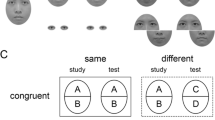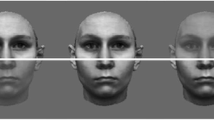Abstract
Using the Garner speeded classification task, Amishav and Kimchi (Psychonomic Bulletin & Review, 17, 743–748, 2010) found that participants could selectively attend to face features: Classifying faces based on the shape of the eyes was not influenced by task-irrelevant variation in the shape of the mouth, and vice versa. This result contrasts with a large body of work using another selective attention task, the composite task, in which participants are unable to selectively attend to face parts: Same/different judgments for one-half of a composite face are influenced by the same/different status of the task-irrelevant half of that composite face. In Amishav and Kimchi, faces all shared a common configuration of face features. By contrast, configuration is typically never controlled in the composite task. We asked whether failures of selective attention observed in the composite task are caused by faces varying in both features and configuration. In two experiments, we found that participants exhibited failures of selective attention to face parts in the composite task even when configuration was held constant, which is inconsistent with Amishav and Kimchi’s conclusion that face features can be processed independently unless configuration varies. Although both measure failures of selective attention, the Garner task and composite task appear to measure different mechanisms involved in holistic face perception.




Similar content being viewed by others
Notes
There are two versions of the composite task in the literature (complete and partial design), and debate over which is more appropriate. Here we use the complete design, which we have empirically demonstrated to be a more reliable and valid measure of holistic face processing (see Richler & Gauthier, 2014, for a review).
Although we are manipulating one aspect of configural information between the DC and SC conditions to determine whether this influences holistic processing (i.e., ability to selectively attend to parts), this should not be interpreted as a manipulation of configural processing (i.e., sensitivity to spatial relations between features), which our experiments are not designed to measure.
The findings were qualitatively the same if all participants (except those discarded due to a programming error) were included in the analyses (SC holistic processing: p = .01, η2 p = .17; DC holistic processing: p < .001, η2 p = .45; congruency × alignment × configuration group: p = .28, η2 p = .02;).
We initially ran an experiment where target part was blocked using the same timing parameters as Experiment 1. The congruency × alignment × configuration interaction was not significant (F 1,64 = 1.72, MSE = .17, p = .20, η2 p = .03). Holistic processing was significant for the DC (N = 33; p = .001, η2 p = .28) but not SC (N = 33; p = .23, η2 p = .04) group. However, these results were difficult to interpret due to a pronounced ceiling effect in the SC condition; blocking by cued part made the task easier because participants knew which part of the study face was relevant, and could (try to) devote all their attention to that part at study. Presentation time was reduced in Experiment 2 to resolve this issue, bringing performance off ceiling levels.
Holistic processing in the DC group did reach statistical significance when all participants (with the exception of those discarded due to a computer error) were included in the analyses (p = .04, η2 p = .09). Including these data did not qualitatively change the other critical effects (SC holistic processing: p = .03, η2 p = .10; alignment × congruency × configuration group interaction: p = .90, η2 p < .00).
References
Amishav, R., & Kimchi, R. (2010). Perceptual integrality of componential and configural information in faces. Psychonomic Bulletin & Review, 17, 743–748.
Cabeza, R., & Kato, T. (2000). Features are also important: Contributions of featural and configural processing to face recognition. Psychological Science, 11, 429–433.
Chua, K.-W., Richler, J. J., & Gauthier, I. (2014). Becoming a Lunari or Taiyo expert: Learned attention to parts drives holistic processing of faces. Journal of Experimental Psychology: Human Perception and Performance, 40, 1174–1182.
DeGutis, J., Wilmer, J., Mercado, R. J., & Cohan, S. (2013). Using regression to measure holistic face processing reveals a strong link with face recognition ability. Cognition, 126, 87–100.
Farah, M. J., Wilson, K. D., Drain, M., & Tanaka, J. N. (1998). What is" special" about face perception? Psychological Review, 105, 482–498.
Freud, E., Avidan, G., & Ganel, T. (2013). Holistic processing of impossible objects: Evidence from Garner’s speeded-classification task. Vision Research, 93, 10–18.
Garner, W. R. (1974). The processing of information and structure. New York: Wiley.
Hole, G. J. (1994). Configurational factors in the perception of unfamiliar faces. Perception, 23, 65–74.
Kimchi, R., & Amishav, R. (2010). Faces as perceptual wholes: The interplay between component and configural properties in face processing. Visual Cognition, 18, 1034–1062.
Kimchi, R., Behrmann, M., Avidan, G., & Amishav, R. (2012). Perceptual separability of featural and configural information in congenital prosopagnosia. Cognitive Neuropsychology, 29, 447–463.
McKone, E., & Yovel, G. (2009). Why does picture-plane inversion sometimes dissociate perception of features and spacing in faces, and sometimes not? Toward a new theory of holistic processing. Psychonomic Bulletin & Review, 16, 778–797.
Melara, R. D., & Mounts, J. R. (1993). Selective attention to Stroop dimensions: Effects of baseline discriminability, response mode, and practice. Memory & Cognition, 21(5), 627–645.
Pomerantz, J. R., Pritstach, E. A., & Carson, C. E. (1989). Attention and object perception. In 8. Shepp & S. Ballesteros (Eds.), Object perception: Structure and process (pp. 53–89). Hillsdale: Erlbaum.
Richler, J. J., & Gauthier, I. (2014). A meta-analysis and review of holistic face processing. Psychological Bulletin, 140, 1281–1302.
Richler, J. J., Cheung, O. S., Wong, A. C.-N., & Gauthier, I. (2009). Does response interference contribute to face composite effects? Psychonomic Bulletin & Review, 16, 258–263.
Richler, J. J., Mack, M. L., Palmeri, T. J., & Gauthier, I. (2011). Inverted faces are (eventually) processed holistically. Vision Research, 51, 333–342.
Richler, J. J., Palmeri, T. J., & Gauthier, I. (2012). Meanings, mechanisms, and measures of holistic processing. Frontiers in Psychology, 3.
Ross, D.A., Richler, J.J., & Gauthier, I. (2014) Reliability of composite task measurements of holistic face processing. Behavior Research Methods.
Rossion, B. (2008). Picture-plane inversion leads to qualitative changes of face perception. Acta Psychologica, 128, 274–289.
Searcy, J. H., & Bartlett, J. C. (1996). Inversion and processing of component and spatial-relational information in faces. Journal of Experimental Psychology: Human Perception & Performance, 22, 904–915.
Susilo, T., Rezlescu, C., & Duchaine, B. (2013). The composite effect for inverted faces is reliable at large sample sizes and requires the basic face configuration. Journal of Vision, 14, 1–9.
Tanzer, M., Freud, E., Ganel, T., & Avidan, G. (2013). General holistic impairment in congenital prosopagnosia: Evidence from Garner’s speeded-classification task. Cognitive Neuropsychology, 30, 429-445.
Van Leeuwen, C., & Bakker, L. (1995). Stroop can occur without Garner interference: Strategic and mandatory influences in multidimensional stimuli. Perception & Psychophysics, 57, 379–392.
Young, A. W., Hellawell, D., & Hay, D. C. (1987). Configurational information in face perception. Perception, 16, 747–759.
Acknowledgments
This work was supported by the NSF (Grants SMA-1041755 and SBE-1257098) and NEI (Grants R01-EY013441 and P30-EY008126). The authors thank Jackie Floyd, Amit Khandhadia, Kaleb Lowe, David Nelwan, Emily Sauder, and Bikang Zhang for assistance with data collection, and Ruth Kimchi for providing her stimuli.
Author information
Authors and Affiliations
Corresponding author
Rights and permissions
About this article
Cite this article
Richler, J.J., Palmeri, T.J. & Gauthier, I. Holistic processing does not require configural variability. Psychon Bull Rev 22, 974–979 (2015). https://doi.org/10.3758/s13423-014-0756-5
Published:
Issue Date:
DOI: https://doi.org/10.3758/s13423-014-0756-5




